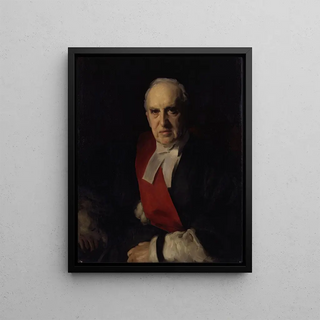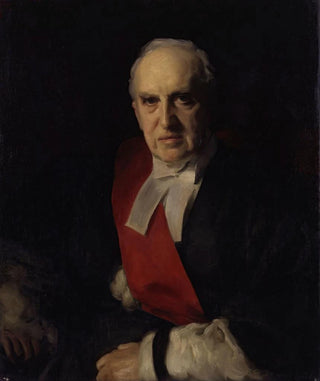Art print | Charles Arthur Russell Baron Russell de Killowen - John Singer Sargent


View from behind

Frame (optional)
John Singer Sargent's art print of "Charles Arthur Russell Baron Russell de Killowen" is a piece that transcends mere portraiture to become a true window into the soul of its subject. Created by one of the masters of portrait art, this work not only showcases Sargent's undeniable talent but also his skill in capturing the very essence of his models' personalities. Gazing upon this art print, the viewer is immediately transported to the atmosphere of the early 20th century, an era where art and social life intertwined harmoniously. The penetrating gaze of Baron Russell seems to invite the observer to delve into the depths of his thoughts, revealing the depth and complexity of his character.
Style and uniqueness of the work
Sargent's style is distinguished by its fluid technique and ability to play with light and shadow. In this piece, the treatment of textures—whether the rich fabrics of the baron's attire or the delicate nuances of his complexion—demonstrates exceptional craftsmanship. Every brushstroke appears to have been chosen with care, creating an atmosphere that is both intimate and majestic. The composition is balanced, highlighting the subject while subtly incorporating decorative elements that enrich the visual narrative. The choice of colors, both vibrant and nuanced, helps bring this representation to life, making the character almost tangible. Sargent thus manages to transcend simple physical representation to offer a true psychological study, where every detail matters and contributes to the whole.
The artist and his influence
John Singer Sargent, born in 1856, is often regarded as one of the greatest portrait artists of his time. His training at the Julian Academy in Paris and his travels across Europe shaped his unique style, blending Impressionist influences with academic techniques. Sargent was not merely an observer of his era but also an innovator who adapted to the artistic evolutions of his time. His portraits, often commissioned by the elite of society, reflect a deep understanding of social conventions while reinterpreting them with a personal touch. The art print "Charles

Matte finish

View from behind

Frame (optional)
John Singer Sargent's art print of "Charles Arthur Russell Baron Russell de Killowen" is a piece that transcends mere portraiture to become a true window into the soul of its subject. Created by one of the masters of portrait art, this work not only showcases Sargent's undeniable talent but also his skill in capturing the very essence of his models' personalities. Gazing upon this art print, the viewer is immediately transported to the atmosphere of the early 20th century, an era where art and social life intertwined harmoniously. The penetrating gaze of Baron Russell seems to invite the observer to delve into the depths of his thoughts, revealing the depth and complexity of his character.
Style and uniqueness of the work
Sargent's style is distinguished by its fluid technique and ability to play with light and shadow. In this piece, the treatment of textures—whether the rich fabrics of the baron's attire or the delicate nuances of his complexion—demonstrates exceptional craftsmanship. Every brushstroke appears to have been chosen with care, creating an atmosphere that is both intimate and majestic. The composition is balanced, highlighting the subject while subtly incorporating decorative elements that enrich the visual narrative. The choice of colors, both vibrant and nuanced, helps bring this representation to life, making the character almost tangible. Sargent thus manages to transcend simple physical representation to offer a true psychological study, where every detail matters and contributes to the whole.
The artist and his influence
John Singer Sargent, born in 1856, is often regarded as one of the greatest portrait artists of his time. His training at the Julian Academy in Paris and his travels across Europe shaped his unique style, blending Impressionist influences with academic techniques. Sargent was not merely an observer of his era but also an innovator who adapted to the artistic evolutions of his time. His portraits, often commissioned by the elite of society, reflect a deep understanding of social conventions while reinterpreting them with a personal touch. The art print "Charles






